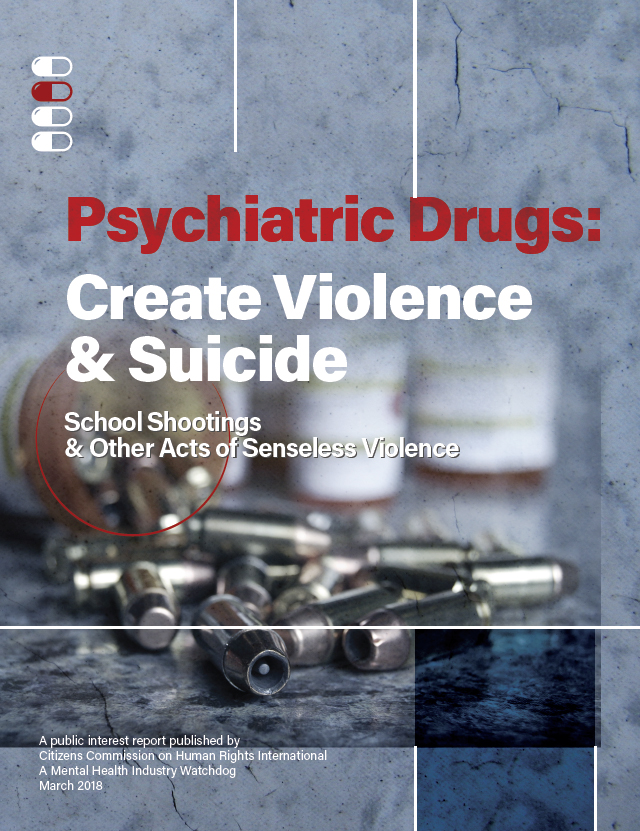By CCHR International
The Mental Health Industry Watchdog
February 25, 2019
The woman suspected of setting fire to a Paris apartment building on February 4, 2019 in which 10 people died, had recently been released from a ward of the Sainte-Anne psychiatric hospital, according to prosecutor Remy Heitz. Sources said she had been treated there for 12 days. On January 30, six days before the deadly blaze, psychiatrists declared her fit to leave. The woman had been treated a dozen times in psychiatric facilities in Paris over the past decade.[1] Citizens Commission on Human Rights International warns that this is but another example where psychiatric treatment not only failed patients but arguably worsened them, causing deaths.
The usual response to such violence is for psychiatrists and their advocates to say that the woman should have been detained longer and given more mental health treatment. This misdirects from the real problem: the treatment given her for 10 years had not worked and could have predisposed her to committing this deadly act. Prosecutors should be investigating the psychiatrists who treated her, and they have a precedent to do so.
In 2012, a French psychiatrist whose patient hacked an elderly man to death was found guilty of manslaughter in a groundbreaking case. A court in Marseilles said Dr. Daniele Canarelli had committed a “grave error” by failing to recognize the public danger posed by Joel Gaillard, her patient of four years. Canarelli was handed a one-year prison sentence and ordered to pay 8,500 euros ($9,500) to the victim’s children, in the first case of its kind in France. Gaillard had already been treated on several occasions for a series of increasingly dangerous incidents.[2] Charges outlined in the court judgment said the four years of the psychiatrist’s treatment of Gaillard were marked “beyond any doubt” with “a succession of failures” and her attitude “resembled blindness.” She “did not question her methodology or change her approach, thus creating or helping to create the situation that led to the realization of the crime.”[3] Not that psychiatrists can predict dangerous behavior—psychiatry’s diagnostic methods are not based on science—but they are aware of the adverse effects of psychiatric drugs, including violence, that emerge.
This case should be a precedent in all acts of violence when the accused was undergoing psychiatric treatment at the time.
In 2017, there was the case of knife-wielding teenager who tried to breach security at the Eiffel Tower in Paris. No one was injured. The 19-year-old was a patient at a mental hospital. He had been in the psychiatric facility for several months and his stay had been renewed for six more months on July 27, according to French press reports. He was granted weekend leave from August 4-6, when the offense occurred. He had previously threatened railway personnel in 2015 and was convicted in December 2016 on charges of defending acts of terrorism and for making death threats. He was given a four-month suspended sentence.[4] Unbelievably, after the Eiffel Tower incident, he was returned to the same hospital that discharged him and, which has failed to cure him of his issues or prevent his violent acts.[5]
In September 2018, a man allegedly wounded seven people in a knife attack in downtown Paris, leaving four people in critical condition. “He had an iron bar in his hand, which he threw at the men chasing him, then, he took out a knife,” the guard told AFP. The Afghan National was said to have “psychiatric problems.”[6] A witness told media that the assailant “didn’t say anything even when we caught him and some asked him: why did you do that? He looked drugged.”[7]
On July 14, 2016, more than 80 people were killed when a man drove a lorry into a crowd celebrating the French National Bastille Day in the southern city of Nice. Mohamed Lahouaiej Bouhlel was known to police because of allegations of threats, violence and thefts over the last six years, and he was given a suspended six-month prison sentence that year after being convicted of violence with a weapon. Bouhlel’s father revealed that his son had had multiple nervous breakdowns.[8] His sister said before leaving Tunisia, where he was born, for France in 2005, her brother had spent years being treated by psychologists.[9] ABC News (Australian Broadcasting Corporation) also reported that the breakdowns, which occurred between 2002 and 2004 had resulted in Bouhlel being prescribed drugs to treat “depression.”[10]
In 2015, France 5 TV aired the documentary, “Dead on Prescription,” which pointed to the proliferation and dangers of psychotropic drugs, including the propensity to commit violent acts. Such drugs are the mainstay of psychiatric treatment in and outside of hospitals. In France, at least 6 million people were taking antidepressants and 11.5 million took benzodiazepines, such as Valium or Xanax every year. An interview with Professor Phillipe Even said antidepressants can cause inhibitions to disappear and individuals taking the drugs can commit violent acts.[11] France reportedly has the highest rate of European psychotropic drug use is in France (19.2%), compared to 5.9% in Germany and 7.4% in the Netherlands.[12]
The documentary interviewed Texas attorney, Andy Vickery, who has been suing pharmaceutical companies over the violence- and suicide-inducing effects of psychotropic drugs for 40 years. Regarding the antidepressant, Prozac, Mr. Vickery said, “The first observation is that the person becomes suddenly suicidal. People who never thought of committing suicide or to do evil take one of these drugs and bang! They suddenly pass from this state to the desire of death. The second observation is that the suicides are generally violent ones….The third part of the puzzle, which is common, is the obsession which one puts to destroy oneself. It is a sudden impulse which pushes one to make an act of an extreme violence or very dangerous against oneself or against the others. And that submerges, that becomes an obsession and one cannot control it any more. Between the moment when the patient starts to take his pill and that of their death or their suicide attempt, there is an abnormal behavior: something does not go right. And sometimes, the answer of the doctor is: ‘Ah! You need more drugs. The amounts should be increased!’ Well, let us see! There is a fire, why not add petrol!”

Click image to read more: Psychiatric Drugs: Create Violence & Suicide—School Shootings & Other Acts of Senseless Violence
Whether or not those committing senseless acts of violence in France were taking mind-altering drugs or withdrawing from, the increasing reports of psychiatric treatment being in assailants’ histories warrants closer scrutiny and the treating psychiatrists in each case should be investigated. Did they see the warning signs? Did they question the role and impact of their “treatments” on the patient? Did they increase the dose of any psychotropic drug? All these are questions that should be asked and answered in any police investigation of violent crimes where the person has undergone psychiatric treatment.
References:
[1]“Paris arson suspect had just been released from psychiatric ward,” Borneo Post, 8 Feb. 2019, http://www.theborneopost.com/2019/02/08/paris-arson-suspect-had-just-been-released-from-psychiatric-ward/.
[2] “French psychiatrist sentenced after patient commits murder,” Reuters, 18 Dec. 2012, https://www.reuters.com/article/us-france-murder-psychiatrist/french-psychiatrist-sentenced-after-patient-commits-murder-idUSBRE8BH13X20121218.
[3] http://www.psychcrime.org/news/index.php?vd=2524&t=Drug+Dealing+Psychiatrists+Should+Be+Held+Accountable+for+
Patient+Deaths%2C+Mental+Health+Watch+Dog+Group+Says.
[4] “Would-be Eiffel Tower attacker undergoing psychiatric exam,” Washington Post, 7 Aug. 2017; “France opens terror probe against Eiffel Tower attacker,” DW, 7 Aug. 2017, http://www.dw.com/en/france-opens-terror-probe-against-eiffel-tower-attacker/a-39988546.
[5] https://www.france24.com/en/20170808-france-eiffel-tower-knife-attacker-returned-psychiatric-hospital.
[6] https://www.theepochtimes.com/man-arrested-after-knife-attack-in-paris-leaves-4-in-critical-condition_2656468.html.
[7] “Paris knife rampage: Two British tourists among seven wounded as bystanders throw boules at attacker,” The Telegraph, 10 Sept. 2018, https://www.telegraph.co.uk/news/2018/09/09/paris-knife-attack-two-british-tourists-among-seven-wounded/.
[8]“Attack in Nice: Truck driver identified as 31-year-old Tunisia native,” CNN, 16 July 2015, https://www.cnn.com/2016/07/15/europe/nice-france-truck/index.html.
[9] “Nice attacker treated for psychological issues before leaving Tunisia: sister,” Reuters, 16 Jul. 2016, https://www.reuters.com/article/us-europe-attacks-nice-attacker-idUSKCN0ZW0PV?il=0.
[10] “Nice attack: What we know about Mohamed Lahouaiej Bouhlel,” ABC News, 16 Jul. 2016, https://www.abc.net.au/news/2016-07-16/what-we-know-about-the-nice-attacker/7634642.
[11] “Dead on Prescription,” France TV 5, 2015.
[12] Alexander Grinshpoon, M.D., Ph.D., M.H.A. et al, “Psychotropic Drug Use in Israel: Results From the National Health Survey,” Prim Care Companion J Clin Psychiatry. 2007; 9(5): 356–363, http://www.ncbi.nlm.nih.gov/pmc/articles/PMC2040286/.



SHARE YOUR STORY/COMMENT